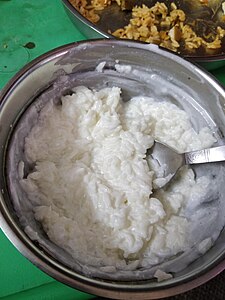Curd rice
tempering | |
Curd rice, also called yogurt rice, is a dish originating from
Etymology
In Rajasthan, the dish is known as auliya.[4] In Gujarat, the dish is known as ghens.[5] In Maharashtra, the dish is known as dahi bhat. In Tamil Nadu, the dish is called thayir saadam or soru. In Kerala, the dish is called tayire chōre. In Telangana and Andhra Pradesh, the dish is called perugannam/daddojanam. In Karnataka, the dish is called mosaranna.
Preparation

While combining steamed white rice and yogurt is the simplest way to make it, more complex techniques can be utilized when necessary. Rice is prepared either via steaming or pressure cooking to be soft as in the South Indian style.
Alternatively, it can be prepared by mashing cooked plain rice (mostly leftovers) with some
In some areas, curd rice is served in a unique style where steamed rice is mixed with mild curd, salted and then tempered with mustard seeds, curry leaves, dry chillies and black gram. Garnishing varies with region, and ranges from grated carrots, pomegranate seeds, raisins, green and purple grapes, fried cashews to grated raw mango and boondi. It can be served lukewarm or chilled. Additional options include a pinch of powdered and roasted asafoetida.[1][2]
Variations of the recipe are countless and are present in all states, reflecting the cuisine of each region. For example, in Karnataka, yogurt chillies (sandige menasu) are commonly added as part of the tempering. Regardless of this, the base components of rice, yogurt, tempered ingredients, and fresh ingredients are consistent, with the different ingredients included in each step varying.

Serving
Curd rice is often eaten accompanied by
Occasions
The dish is both an everyday food and a food served on special occasions. The dish is a staple of traditional cuisine, with the untempered version present at the end of almost every Indian meal during summers. In Rajasthan and Gujarat, curd rice varieties auliya and ghens are prepared for the
See also
- Cuisine of India
- List of rice dishes
- Rice congee
- South Indian cuisine
- Udupi cuisine
References
- ^ a b c d e Chandra, Smita (1991). From Bengal to Punjab: The Cuisines of India. Crossing Press, p. 121.
- ^ a b c d e Plunkett, Richard, Teresa Cannon, Peter Davis, Paul Greenway, and Paul Harding (2001). Lonely Planet: South India, p. 127.
- ^ Advantages of curd and curd rice:https://indianexpress.com/article/lifestyle/health/curd-rice-dahi-chawal-yoghurt-winter-6141196/
- ^ Mathur, Neha (2022-05-01). "Rajasthani Namkeen Oliya". Whisk Affair. Retrieved 2023-04-25.
- ^ dee (2021-01-19). "Kanki/Ghens (Gujarati Rice Porridge)". The Weekly Munch. Retrieved 2023-04-25.
- ^ Thayir Sadaam(Curd Rice):https://food.ndtv.com/recipe-thayir-saadam-curd-rice-218370
